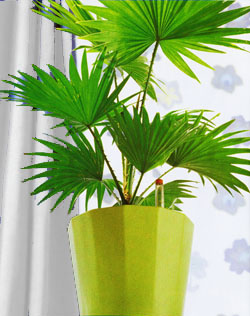How Clean Is the Air You're Breathing?
When people talk about environmental pollution, it's natural to think about global warming, oil spills, and contaminants polluting our oceans and lakes. But there is another danger that is lurking much closer to home than you may realize.
It's indoor air pollution.
Air pollution in general is a significant risk to our health, contributing to resporitory infections, heart disease, and lung cancer. "Bad air days" make it hard to breathe and cause irritated eyes, noses, and lungs.
Research has shown that indoor air can be as much as 5 times more polluted than outside air!
 The air you're breathing at your desk is probably more polluted than outdoor air!
The air you're breathing at your desk is probably more polluted than outdoor air!The Environmental Protection Agency (EPA) ranks INDOOR AIR POLLUTION as one of the top 5 threats to public health. In fact, as you sit at your desk reading this you're likely breathing in bacteria, allergens, and a variety of other chemical toxins.
These include, formaldehdye (found in particle board used in furniture, household cleaning agents, carpet), benzene (printer inks, paint, plastics, dye), andtrichloroethylene THC (adhesives, varnish, paint, lacquer).
Without proper ventilation, these air pollutants are concentrated right where you spend most of your time indoors - at your desk.
How can this happen?
 To conserve energy, today's buildings are sealed from the outdoors.
To conserve energy, today's buildings are sealed from the outdoors.After the energy crisis in the 1970's, the building industry began sealing buildings from outside air to maximize energy efficiency. The architects and engineers designing these buildings didn't see the effect this would have on the quality of air inside. Consequently, a significant number of illnesses began appearing from the buildings that were sealed to reduce energy costs.
Air quality is very important to our health. We breathe approximately 22,000 times a day. Constant exposure to even low levels of toxic compounds in the air can cause a host of health concerns.
Fortunately, nature has given us a valuable weapon in the fight against rising levels of indoor air pollution - live plants!
Live plants in your home or office are not only decorative, research has found them to be surprisingly effective at absorbing harmful pollutants too. Living plants freshen our living and working spaces naturally.
Indoor Plants - take a closer look . . . .

In the 1980's NASA discovered that ordinary houseplants can remove toxins from the air. Their research determined that plants can actually convert toxic pollutants found in the air into food the plant can use - without harming the plant!
When it comes to removing toxins from the air, it's the plant's root zone does most of the work. This requires air movement at the roots and our hydroponic system promotes better air movement through the root zone than any other method for growing.
Research is finding that hydroponic plants can be up to 10 times more effective at removing harmful toxins from the air than plants growing in soil.
Hydroponic plants are efficient, pollution absorbing machines!
Indoor Air Pollution - What is it?

